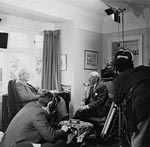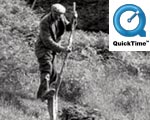






 |
|||||
 |
 |
 |
 |
 |
 |
|
Scottish Film Culture Before 1938 The First Films of Scotland Committee Scottish Film Culture Between the Committees The Second Films of Scotland Committee Production Distribution & Exhibition
|
The First Films of Scotland CommitteeFormationThe first Films of Scotland Committee was set up by the Scottish Secretary of State and the Scottish Development Council with the stated object of fostering and encouraging the production of Scottish films of national interest. The first seven films the Committee produced were primarily for the 1938 Glasgow Empire Exhibition. The most comprehensive surviving documentation on the institutional formation and philosophy of the First Committee is a script for a BBC radio programme Grierson participated in in 1938. As Grierson (1938) put it in the broadcast; 'Here is a prospect of all sorts of people being specially interested in Scotland in 1938 and a chance to focus their interest in the life and achievement of our country. What medium can do it better than film?' (p. 5). |
|
 Author Neil Gunn, another member of the first committee. Here a subject of one of the second committee's documentaries. |
The seven films the Committee produced for the Empire Exhibition were Wealth of a Nation (1938), on Scottish industry and town planning; The Face of Scotland (1938), a broad history of Scotland and the Scottish 'character'; They Made the Land (1938), a history of Scottish agriculture; The Children's Story (1938), on Scottish education; Sea Food (1938); Scotland for Fitness (1938); and Sport in Scotland (1938). The Films of Scotland Committee was appointed by the Scottish Development Council in consultation with Walter Elliot, the Secretary of State for Scotland and the Permanent Under Secretary of State, Sir Horace Hamilton, for an initial three year period. In his broadcast, Grierson noted that Walter Elliot, then Under Secretary of State for Scotland, had played an active role in the development of the Empire Marketing Board's use of film. The Chairman of the Committee was Gilbert Archer, and Grierson acted as production advisor as part of the service offered by his Film Centre (also set up in 1938). Other members of the Committee included Sir Alexander King, later to become the chairman of the second Films of Scotland Committee, Neil Gunn and O. H. Mavor (alias James Bridie). Finance was limited, with most of the money coming from other government QUANGOS such as the Commissioner for Special Areas, the National Fitness Council and the British Council for Cultural Relations Overseas. In his radio talk Grierson expressed surprise that apart from £5,000 contributed by the Glasgow industrialist Sir John MacTaggart, industrial companies were less forthcoming than the civil service. As we shall see, this was to change significantly with the formation of the second committee, and begins to suggest that despite their institutional similarities, the two committees played a fundamentally different role. |
 They Made The Land (1938) centers on the toil involved in transforming the Scottish landscape from hillside peat bog to agricultural farm land.
|
DistributionThe documentaries were not only produced for the Glasgow Empire Exhibition. In his radio talk Grierson noted that 'We want to see these pictures of Scotland all over the country, so that Scotsmen themselves might learn a little more of what was happening under the surface of national life' (p. 5). Forsyth Hardy (1990), director of the second Committee for nineteen years (1955-1974), notes that the first seven Films of Scotland documentaries had 4,725 showings in British cinemas, and estimates the total audience at 22,491,000 (p. 235). They Made the Land was still in circulation when the second Films of Scotland Committee was set up in 1955 and The Face of Scotland had only just been withdrawn (Scottish Council, 1961, September 1). Grierson also talked about sending the documentaries 'across the border' and 'overseas to the Empire and the world' (p. 6). The intention had also been to screen the documentaries at the 1939 New York World Fair, but the British Council refused to allow them to be shown on the grounds that they failed to present 'a sufficiently ceremonial or picturesque presentation of life in Britain' (Hardy quoted in Caughie & McArthur, 1982, p. 75). Nevertheless, Grierson managed to get the films screened in an American social science pavilion. The functional nature of the documentaries is indicated by the fact that a letter from the Commonwealth Relations Office (1957, May 8) to the Committee states that 'the Crown Agents have been requested to purchase a 16mm print of They Made the Land [...] for presentation to the Government of Thailand under the Technical Co-operation scheme of the Colombo plan'. |
DundeeGrierson (1938) argued that the Committee had its sights set beyond these seven films; 'We are not thinking of just making a spurt in the year of the Exhibition. We have set ourselves to the task of seeing that Scotland is henceforward as adequately represented on the screen as our national means will allow' (p. 8). But before the war broke out, the Committee were successful in producing only one other film, the history of which is instructive because it pre-empts the financing and filmmaking activities of the second Films of Scotland Committee. The Dundee Chamber of Commerce Yearbook (1938) charts the Committee's attempt to persuade the Chamber to sponsor a twenty minute film 'of the Tay Valley, culminating in Dundee and its industries' (p. 95). The Committee offered to produce and distribute the film if Dundee Chamber of Commerce came up with the cash. A letter to the Town Clerk of Dundee dated March 27 from John Graham, the secretary of the Films of Scotland Committee stated that the Committee had 'always had in mind the production of films portraying the various important Scottish areas, and for this purpose they hope to enlist the support of civic authorities, industrial and other interests' (p. 114). Dundee was the first Local Authority to be approached in connection with the production of a film of its respective area, but it refused to do anything until similar steps had been taken by Glasgow and Edinburgh. By June of that year the Committee had already received contributions towards the film amounting in aggregate to £1,174 2s 0d from various other sources and production of Dundee (1938) went ahead. Dundee is significant economically because the Committee attempted to produce it by approaching and persuading public and industrial bodies with a potential vested interest in the production of such a film to finance it themselves. The pay back for investors would be the promotion of their industry or region; a public relations exercise rather than a hard sell. As we shall see, this attempt prefigures the way in which the Second Committee financed production. Dundee is significant generically because it 'looks' more like the films produced by the second Committee than the first. While principally a documentary about industrial activity on the Tay valley, and therefore not that different in subject from Wealth of a Nation, Dundee is structured along the lines of a travelogue; narrative and travel organise its production of knowledge about Tayside. It could be argued then that the documentary abandons the paternalist voice-of-God narration of the other 1938 documentaries for a more populist conversational approach. |
|


|
|
| Author: Richard Butt | Images are drawn from the SCRAN database. |